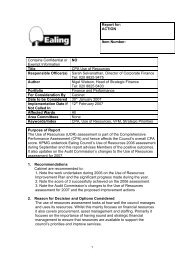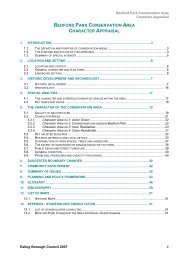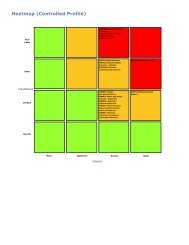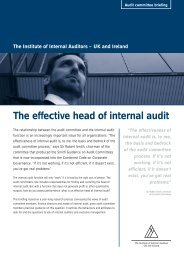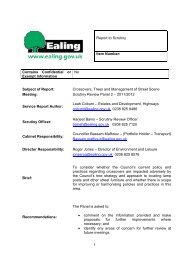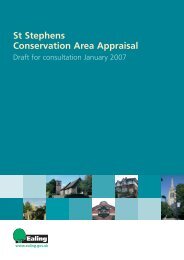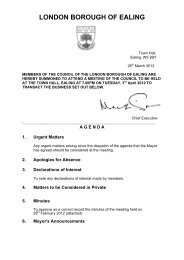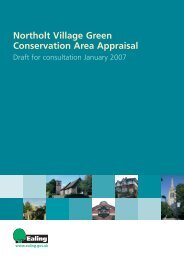St Marks and Canal Conservation Area Appraisal - Ealing Council
St Marks and Canal Conservation Area Appraisal - Ealing Council
St Marks and Canal Conservation Area Appraisal - Ealing Council
- No tags were found...
Create successful ePaper yourself
Turn your PDF publications into a flip-book with our unique Google optimized e-Paper software.
<strong>St</strong>. Mark’s <strong>and</strong> <strong>Canal</strong> <strong>Conservation</strong> <strong>Area</strong>Character <strong>Appraisal</strong>3. Historic development <strong>and</strong>archaeology3.1. Historic developmentIn the 18 th Century much of this area was still part ofHanwell Heath, with small village settlements clusteredalong <strong>and</strong> around Uxbridge Road. The character of thearea was mainly rural <strong>and</strong> the principal activities werefarming <strong>and</strong> agriculture. (See Hanwell Map in 1800 Andthe Enclosure Map of 1837)Towards the end of the 18th Century <strong>and</strong> during the 19 thCentury, major changes to this area occurred, thusgradually transforming its rural nature into a moresuburban character.Firstly, the construction of the Gr<strong>and</strong> Junction <strong>Canal</strong>between 1793 <strong>and</strong> 1814 was a major event thatcontributed to this transition. The Gr<strong>and</strong> Junction <strong>Canal</strong>was London's principal link with the rest of the UK's canalsystem. It provided the transport infrastructure to bringgoods from the industrial conurbations of the north <strong>and</strong>midl<strong>and</strong>s to the capital. The Act of Parliament toauthorise its construction was passed in 1793 <strong>and</strong> workstarted in the same year. The construction of The Gr<strong>and</strong>Junction <strong>Canal</strong> brought labourers into the parish frommany parts of the country, leading to the intensification ofconstruction activity in the area <strong>and</strong> the building of workercottages as well as larger houses.The building of Middlesex County Asylum on thesouthern section of <strong>St</strong> <strong>Marks</strong> CA also contributed to thetransformation of the character of the area. Work on thenew asylum started in 1829 on l<strong>and</strong> to a major part (44acres) purchased from the Earl of Jersey. The architectwas William Alderson.The neo-classical design consisted of a central octagonalpanoramic tower with a basement <strong>and</strong> two floors. Thewindows have a tall aspect with semicircular bondedgauge brick arches at the top. The east side of thecentral tower was intended for the male <strong>and</strong> the westernfor the female patients. The newer extensions whichwere added in 1859 are readily identifiable by their flatbonded arches to the tops of the windows 2 . Hanwell waschosen for its position outside of centres of population,but not too far for the occasional visit from London.Brent Bridge in the 19 th CenturyUxbridge Road passing over BrentBridge (now Hanwell Bridge) in the early20 th CenturyBrent Bridge in the early 20 th Century2 Roberts, A; Cracknell, P.; Piddock, S.; Rutherford, S.(1981). Asylum architecture. The asylumsindex. Middlesex University, London, Engl<strong>and</strong>. Retrieved on 2006-09-26.<strong>Ealing</strong> Borough <strong>Council</strong> 2006 9Windmill portrayed by J.W.M Turner in1810




